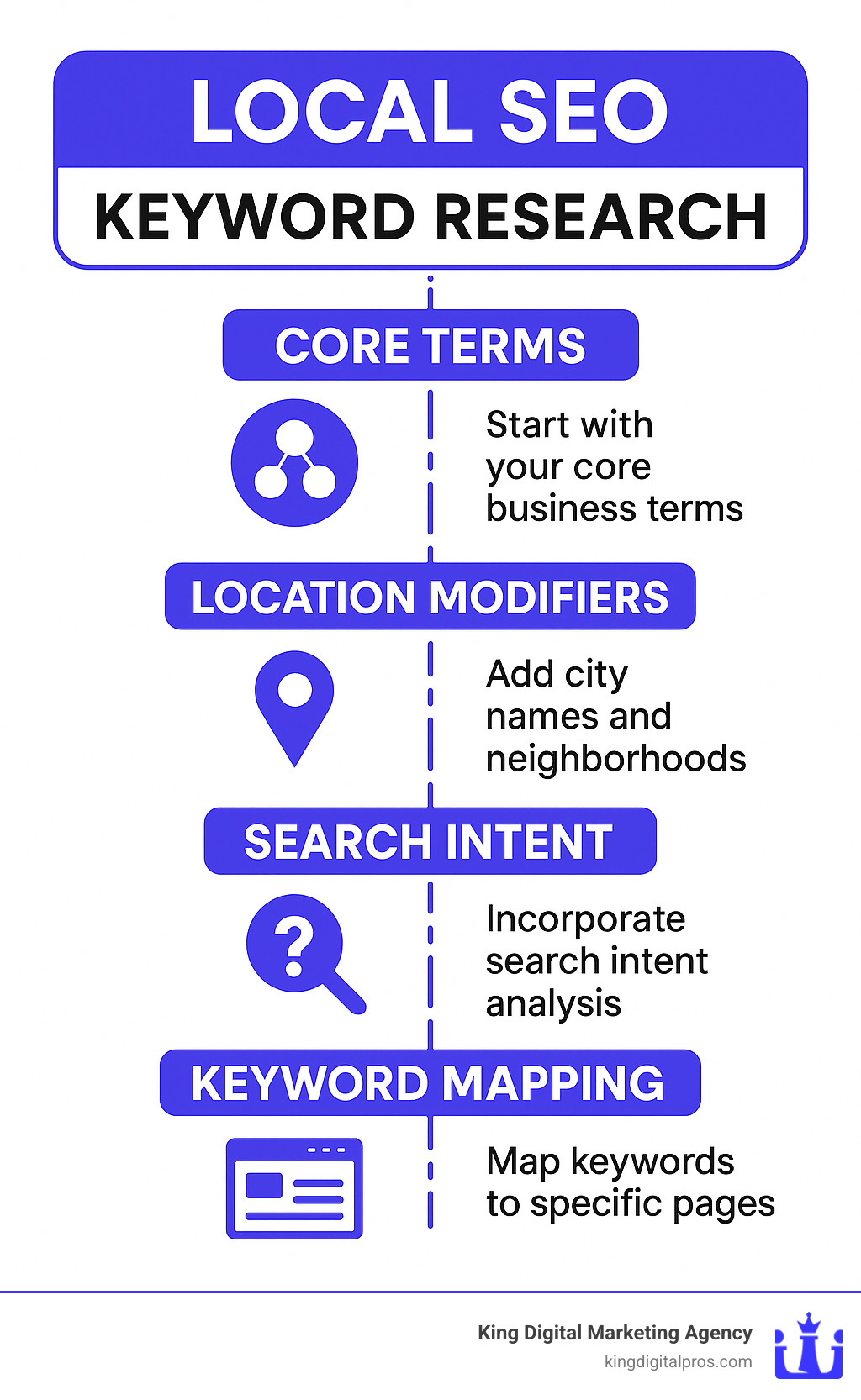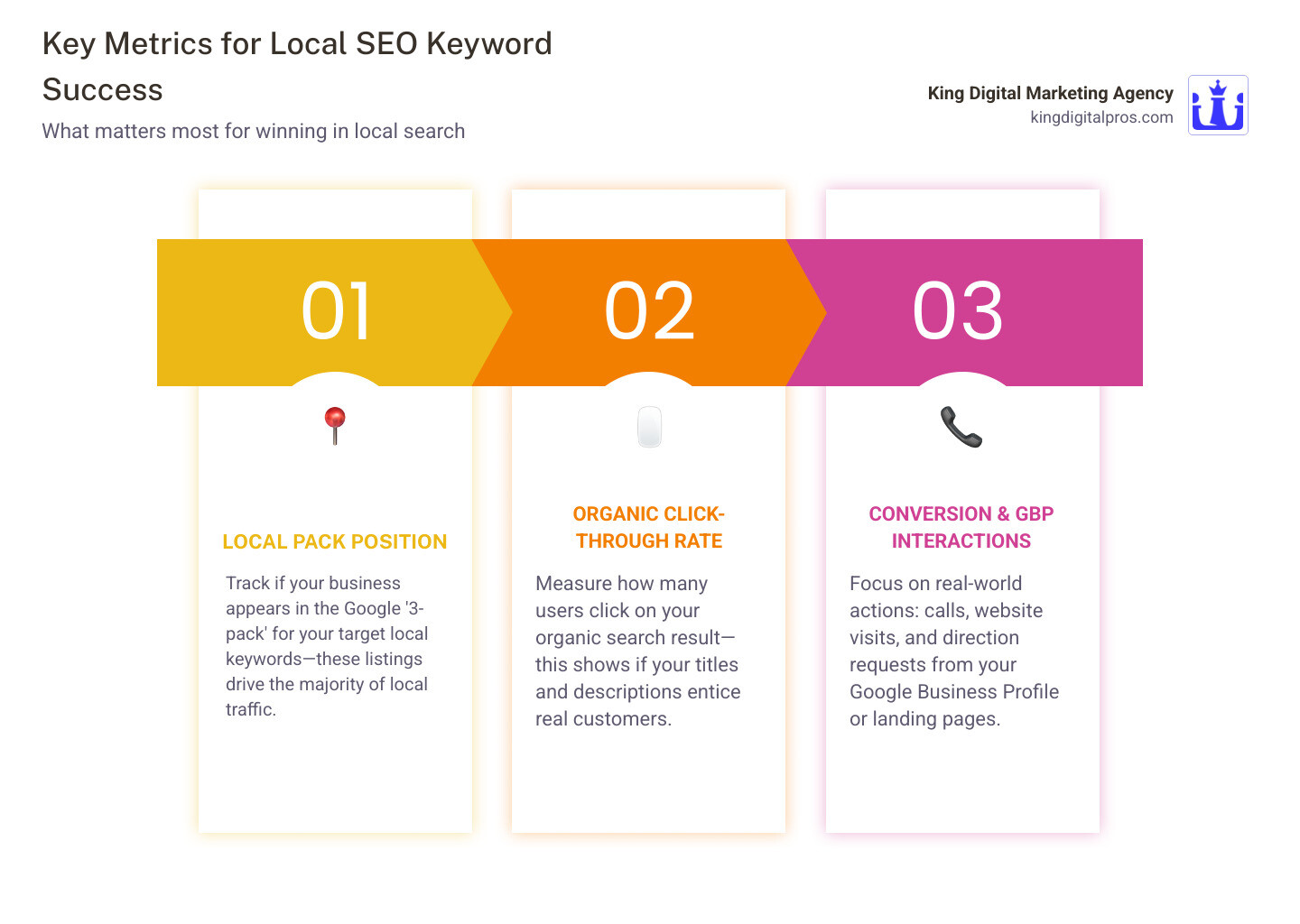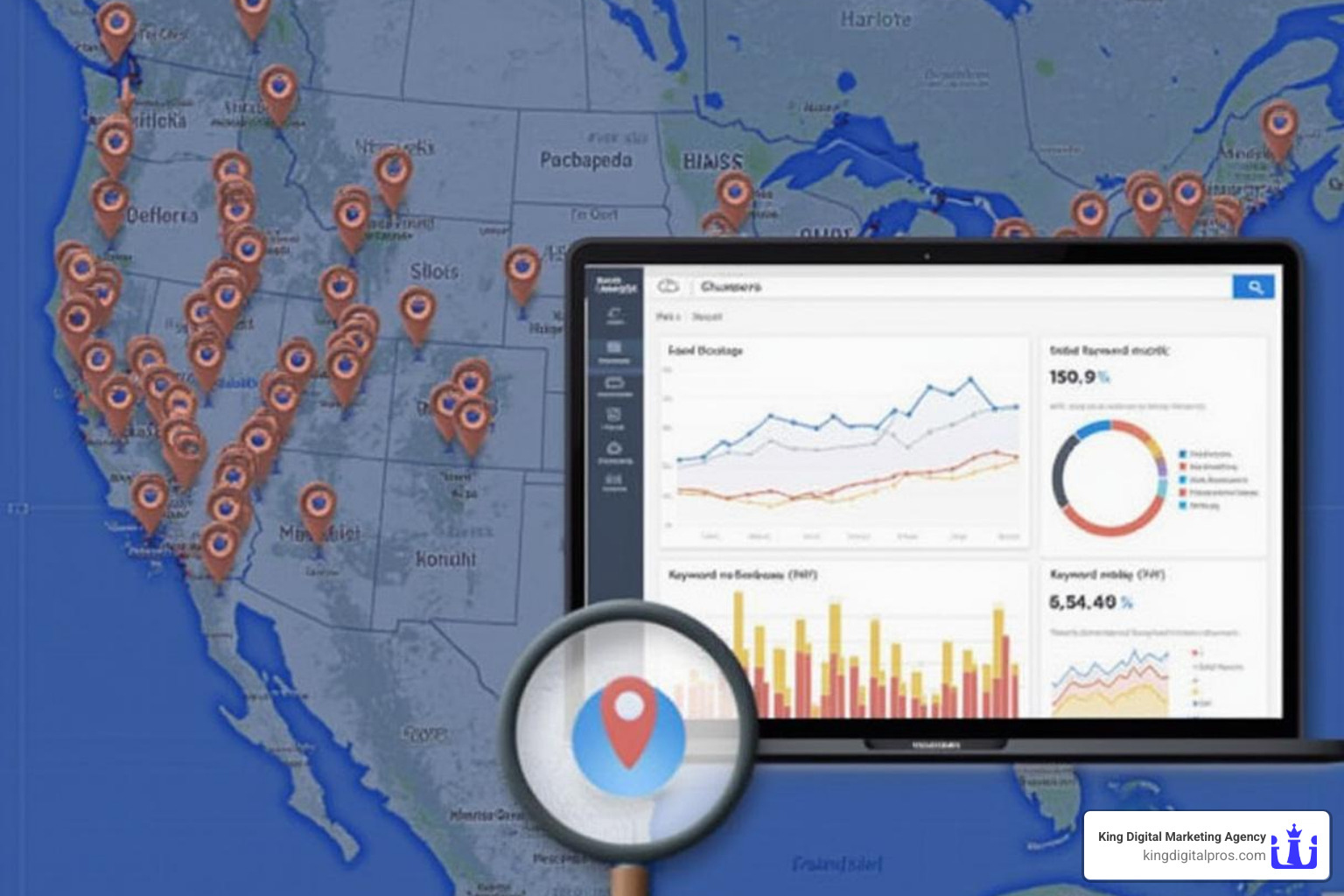Why Local SEO Keyword Research is Your Business’s Secret Weapon
Local SEO keyword research is the process of finding and analyzing search terms that people use when looking for products, services, or businesses in their specific geographic area. Here’s what you need to know:
Key Components of Local Keyword Research:
- Core terms – your main services (dentist, plumber, pizza)
- Modifiers – descriptive words (best, affordable, emergency)
- Location terms – geographic identifiers (city, neighborhood, “near me”)
- Search intent – what users want (info, directions, to buy)
Why It Matters:
- 80% of consumers go online multiple times weekly to find local businesses
- Nearly 1/3 of all mobile searches are location-related
- Local searches lead to higher conversion rates than general searches
- Helps you appear in Google’s local pack and Maps results
If you’ve ever wondered why your business doesn’t show up when people search for what you offer in your area, the answer usually lies in keyword research. Most local business owners guess at what their customers are searching for – and they’re often wrong.
The reality is that customers don’t always search the way you think they do. They might search for “24 hour locksmith downtown” instead of “locksmith services,” or “kids haircuts near mall” instead of “children’s salon.” Without proper research, you’re shooting in the dark.
I’m Bernadette King, and I’ve helped dozens of local businesses transform their online visibility through strategic Local SEO keyword research. My approach combines data-driven insights with real customer language to help businesses like yours dominate local search results.

Local SEO Keyword Research Fundamentals
Step-by-Step Framework to Find Winning Local Keywords
Finding the right local keywords isn’t guesswork. Use this streamlined, five-step framework to go from broad ideas to pages that actually rank and convert.
Attracting Customers via Google Maps
Step 1 – Identify core services, products, and audiences
- List every service or product you actually sell.
- Scan call logs, emails, and chat transcripts to collect the exact words prospects use.
- Ask front-desk or field staff: “What do people call about most?”
Real phrases beat industry jargon every time.
Step 2 – Expand with keyword modifiers & hyperlocal slang
Add intent and location clues to each core term:
- Quality/price: best, affordable, luxury, budget, emergency, 24-hour.
- Hyperlocal cues: landmarks (“near UNM”), neighborhoods (“Nob Hill”), zip codes.
- Seasonal twists: “AC repair summer” or “ski rental winter”.
Locals often search the way they talk—learn the nicknames and shorthand they use for your city or district.
Step 3 – Add geographic layers & “near me” responsibly
Think in expanding circles:
- Neighborhood → nearby districts → full city → adjacent cities you serve.
- Include zip-code pages if you travel to customers (e.g., “87124 plumber”).
- Use “near me” sparingly for emergency or on-the-go queries; Google now recognizes location intent even when it’s implicit.
(See Google’s research on mobile location trends: Think with Google)
Step 4 – Analyze search intent in Local SEO keyword research
Match your content type to the dominant intent you see in live search results:
- Informational – blog posts, how-to guides.
- Navigational – brand/FAQ pages that confirm hours, address, parking.
- Commercial – comparison pages (“best plumber in Albuquerque”).
- Transactional – service pages with clear CTAs (“schedule drain cleaning today”).
Step 5 – Cluster, map & create URL strategy
Group related keywords, then assign one primary keyword (plus close variants) to each URL:
- Dedicated pages for high-traffic services or major cities.
- Supporting posts for questions and tips that link back to service pages.
- Prevent cannibalization by ensuring no two pages chase the same term.
Use our free keyword mapping template to keep everything organized.
This lean process uncovers real search demand, locks it to clear URLs, and leaves room for new keyword findies as your market evolves.
Tools, Metrics & Tracking

Effective Local SEO keyword research requires the right tools and metrics to guide your decisions. While there are dozens of keyword research tools available, we’ve found that a combination of free and low-cost tools often provides the best results for local businesses.
Free & low-cost tool stack for local findy
Google-based tools (all free):
- Google Keyword Planner – Essential for search volume data and keyword ideas
- Google Trends – Perfect for understanding seasonal patterns and regional interest
- Google Autocomplete – Shows real-time search suggestions
- People Also Ask – Reveals related questions people are searching for
- Google Search Console – Shows what keywords you’re already ranking for
Additional free tools:
- AnswerThePublic – Generates question-based keywords
- I-Search-From – Lets you see search results from different locations
The key is understanding what each tool does well and where it falls short. Google Keyword Planner gives you search volume data but often shows ranges rather than exact numbers. Google Trends helps you understand seasonal patterns but doesn’t give you absolute search volumes.
Tool combination strategy:
- Start with Google Keyword Planner for volume estimates
- Use Google Trends to understand seasonal patterns
- Check Google Autocomplete for real-time suggestions
- Validate with People Also Ask for related queries
- Cross-reference with your Google Search Console data
Measuring success & maintaining momentum
Key metrics for local keyword success:
- Local pack rankings – Position in the map results
- Organic rankings – Position in regular search results
- Click-through rates – How often people click your listings
- Conversion rates – How many clicks become customers
- Google Business Profile views – Visibility in local search
Tracking tools and frequency:
- Check rankings weekly for important keywords
- Review Google Business Profile insights monthly
- Analyze Google Search Console data monthly
- Conduct full keyword audits quarterly
The most successful local businesses treat keyword research as an ongoing process, not a one-time project. Search patterns change, new competitors enter the market, and customer language evolves. Regular monitoring and updates keep your strategy fresh and effective.
Advanced Strategies: Multi-Location, Voice & “Near Me” Evolution
As Local SEO keyword research becomes more sophisticated, businesses need to evolve beyond basic location targeting to capture emerging search opportunities. The landscape is shifting rapidly, with voice search, AI-powered answers, and multi-location strategies becoming essential for staying competitive.
Scaling research for franchises & service areas
Managing Local SEO keyword research for multiple locations requires a completely different approach than single-location optimization. The challenge isn’t just multiplying your efforts – it’s understanding how search behavior varies across different markets and service areas.
Multi-location businesses face unique keyword challenges. What works in Albuquerque might not work in Santa Fe, even for the same business. Local competition, customer language, and search patterns can vary dramatically between markets. We’ve seen businesses struggle because they applied a one-size-fits-all keyword strategy across all their locations.
The solution lies in location clusters and hub-and-spoke architecture. This means creating a main service page for each core offering, then developing location-specific pages that address local needs and search patterns. For example, a plumbing company might have a main “drain cleaning” page, with separate location pages for “drain cleaning Albuquerque” and “drain cleaning Santa Fe” that reflect local competition and customer language.
NAP consistency becomes critical when scaling keyword research across multiple locations. Each location needs its own Google Business Profile with consistent Name, Address, and Phone information. Any inconsistencies can confuse Google and hurt your local rankings across all locations.
Citation audits become more complex but more important as you scale. You need to ensure that each location’s information is consistent across all online directories and platforms. This consistency reinforces your keyword targeting and helps Google understand your service areas.
Optimizing for voice, zero-click & AI answers
Voice search is fundamentally changing how people find local businesses. The way someone speaks a search query is completely different from how they type it. Instead of typing “plumber Albuquerque,” they might ask their phone “Where can I find a good plumber near me?”
Question phrases and conversational keywords are becoming essential for Local SEO keyword research. People ask their devices complete questions like “What’s the best pizza place in Santa Fe?” or “Who can fix my air conditioner today?” These longer, more conversational queries require different content strategies than traditional keyword targeting.
The rise of zero-click searches means Google is answering more questions directly in the search results without users clicking through to websites. This might seem like a problem, but it’s actually an opportunity. When your business information appears in these direct answers, you’re getting prime visibility even without the click.
FAQ schema and structured data help Google understand your content better and increase your chances of appearing in these featured snippets. By organizing your content to answer common questions directly and concisely, you’re positioning yourself for these valuable zero-click opportunities.
Voice search optimization also means thinking about prominence signals differently. Voice assistants often choose results based on factors like review ratings, business profile completeness, and local authority signals. This makes your overall local SEO strategy even more important than individual keyword targeting.
The future of local search is moving toward AI-powered answers and voice interactions. Businesses that optimize for these trends now will have a significant advantage as these technologies become more prevalent. The key is balancing traditional keyword targeting with these emerging search behaviors.
Frequently Asked Questions about Local SEO Keyword Research
How often should I update my local keyword strategy?
Local SEO keyword research should be reviewed and updated regularly, but the frequency depends on your business type and market dynamics. We recommend:
- Monthly reviews for highly competitive markets or seasonal businesses
- Quarterly updates for most local businesses
- Semi-annual comprehensive audits for stable markets
Seasonal businesses need to pay special attention to search patterns. For example, HVAC companies in New Mexico see different keyword patterns in summer (AC repair) versus winter (heating repair).
Can I rank without stuffing “near me” in every sentence?
Absolutely! In fact, keyword stuffing hurts your rankings and user experience. Google’s algorithms are sophisticated enough to understand local intent without explicit location modifiers on every page.
Best practices:
- Use location terms naturally in your content
- Focus on providing value to users first
- Include location information in key places (title tags, headers, business descriptions)
- Let context and user experience guide your keyword usage
What metrics matter most when tracking local keyword success?
Priority metrics for local keyword tracking:
- Local pack positions – These often drive the most traffic
- Organic click-through rates – More important than just rankings
- Conversion rates – What matters for your business
- Google Business Profile interactions – Calls, direction requests, website visits
The goal isn’t just to rank well – it’s to attract customers who are ready to buy your products or services.

Conclusion
Local SEO keyword research isn’t just another marketing task to check off your list – it’s the compass that guides your entire local digital marketing strategy. When you truly understand how your customers search for what you offer, you can meet them exactly where they are in their journey from problem to solution.
Think about it this way: every day, potential customers in your area are typing questions into Google, looking for exactly what your business provides. The difference between thriving local businesses and struggling ones often comes down to whether they’re speaking the same language as their customers online.
The systematic approach we’ve outlined here eliminates the guesswork. By starting with customer language rather than industry jargon, you ensure your content resonates with real people facing real problems. When you expand with local modifiers and hyperlocal terms, you capture the nuanced ways people actually search in your specific market.
Matching content to search intent transforms your website from a digital brochure into a customer magnet. Someone searching for “emergency plumber Albuquerque 2am” has very different needs than someone researching “how to prevent frozen pipes.” Understanding this difference is what separates effective local SEO from shots in the dark.
Perhaps most importantly, tracking and adjusting regularly keeps your strategy fresh and effective. Local search patterns evolve constantly. New competitors enter your market, customer language shifts, and seasonal trends emerge. The businesses that stay on top of these changes are the ones that dominate local search results year after year.
At King Digital Marketing Agency, we’ve seen how proper Local SEO keyword research transforms local businesses. Our expert Google Business Profile optimization helps businesses across the country turn their map listings into customer magnets. We combine the strategic framework you’ve learned here with deep technical expertise to deliver results that matter – more visibility, more customers, and more revenue.
The research is done, the framework is proven, and the tools are available. Whether you’re a solo entrepreneur or managing multiple locations, these principles will help you open up local SEO success one keyword at a time. The only question now is: are you ready to start speaking your customers’ language?

